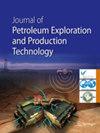New approach of evaluating fracturing interference based on wellhead pressure monitoring data: a case study from the well group-A of Fuling shale gas field
IF 3.2
4区 工程技术
Q3 ENERGY & FUELS
Journal of Petroleum Exploration and Production Technology
Pub Date : 2023-10-19
DOI:10.1007/s13202-023-01713-3
引用次数: 0
Abstract
Abstract Well pattern infilling has become an effective means for improving the development effect of gas reservoirs in unconventional gas reservoirs. The hydraulic fracturing of infill wells causes widespread fracturing interference between new and old wells. Because fracturing interference has a significant influence on the production of old wells, it is urgent to evaluate the degree of fracturing interference. This paper proposes a new approach to evaluating fracturing interference between new and old wells, which is based on a systematic analysis of the variation pattern of old well wellhead fracturing during the fracturing process of new wells. This new approach not only provides a semi-quantitative evaluation for the degree of fracturing interference between fracture sections of new and old wells but also achieves inter-well connectivity evaluation between new and old wells. This new approach is applied in well group A of the Fuling gas field to demonstrate its analysis process. The results show the different types of fracturing interference result in different levels of pressure response between each fracturing section and the old wells. For example, The pressure rise of old well A7-1 is more obvious in the fracturing process of the 2nd, 14th, and 13th sections of new well A68-5, and the old well A7-2 has significant fracturing interference with the 1st, 2nd, 3rd, 4th, and 6th sections. This achieves a semi-quantitative characterization of fracturing interference between new and old wells. The degree of fracturing interference between the old well A7-2 and the new well A68-5 is the strongest in well group A, which is the effect of compression fracture interference. The old wells A7-3 and A15-3 are the least impacted by fracturing interference, and follow the old wells A15-2 and A7-1. This result has implications for assessing the degree of fracturing interference and inter-well connectivity in unconventional gas reservoirs.

基于井口压力监测数据的压裂干扰评价新方法——以涪陵页岩气田a井组为例
摘要在非常规气藏中,井网充填已成为提高气藏开发效果的有效手段。水力压裂充填井造成了新老井间普遍存在的压裂干扰。由于压裂干扰对老井的生产影响较大,因此对压裂干扰程度进行评价是当务之急。本文在系统分析新井压裂过程中老井井口压裂变化规律的基础上,提出了一种评价新老井压裂干扰的新方法。该方法不仅对新老井裂缝段之间的压裂干扰程度进行了半定量评价,而且实现了新老井间连通性评价。以涪陵气田A井组为例,说明了该方法的分析过程。结果表明,不同类型的压裂干扰导致各压裂段与老井之间的压力响应程度不同。例如,A68-5新井2、14、13段压裂过程中,A7-1老井压力上升较为明显,A7-2老井与1、2、3、4、6段压裂干扰明显。这实现了新老井压裂干扰的半定量表征。A井组中老井A7-2与新井A68-5的压裂干扰程度最强,为压缩裂缝干扰效应。A7-3和A15-3老井受压裂干扰影响最小,其次是A15-2和A7-1老井。这一结果对评估非常规气藏的压裂干扰程度和井间连通性具有重要意义。
本文章由计算机程序翻译,如有差异,请以英文原文为准。
求助全文
约1分钟内获得全文
求助全文
来源期刊
CiteScore
5.90
自引率
4.50%
发文量
151
审稿时长
13 weeks
期刊介绍:
The Journal of Petroleum Exploration and Production Technology is an international open access journal that publishes original and review articles as well as book reviews on leading edge studies in the field of petroleum engineering, petroleum geology and exploration geophysics and the implementation of related technologies to the development and management of oil and gas reservoirs from their discovery through their entire production cycle.
Focusing on:
Reservoir characterization and modeling
Unconventional oil and gas reservoirs
Geophysics: Acquisition and near surface
Geophysics Modeling and Imaging
Geophysics: Interpretation
Geophysics: Processing
Production Engineering
Formation Evaluation
Reservoir Management
Petroleum Geology
Enhanced Recovery
Geomechanics
Drilling
Completions
The Journal of Petroleum Exploration and Production Technology is committed to upholding the integrity of the scientific record. As a member of the Committee on Publication Ethics (COPE) the journal will follow the COPE guidelines on how to deal with potential acts of misconduct. Authors should refrain from misrepresenting research results which could damage the trust in the journal and ultimately the entire scientific endeavor. Maintaining integrity of the research and its presentation can be achieved by following the rules of good scientific practice as detailed here: https://www.springer.com/us/editorial-policies

 求助内容:
求助内容: 应助结果提醒方式:
应助结果提醒方式:


